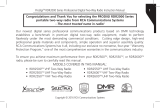1
English
CONTENTS
CONTENTS
Computer Software Copyrights . . . . . . . 3
Safety . . . . . . . . . . . . . . . . . . . . . . . . . . . . 4
Product Safety and RF Exposure
Compliance . . . . . . . . . . . . . . . . . . . . . . . . 4
Radio Overview . . . . . . . . . . . . . . . . . . . . 5
Operation and Control Functions . . . . . . . . 6
Radio Controls . . . . . . . . . . . . . . . . . . . 6
Programmable Buttons . . . . . . . . . . . . . 7
Menu Keys . . . . . . . . . . . . . . . . . . . . . . . . 10
LCD Display and Icons . . . . . . . . . . . . 11
Menu Navigation Chart . . . . . . . . . . . . 11
Audio Signal Tones. . . . . . . . . . . . . . . 12
Getting Started . . . . . . . . . . . . . . . . . . . . 14
Battery Information. . . . . . . . . . . . . . . . . . 14
Battery Care and Tips . . . . . . . . . . . . . 14
Recycling or Disposal of Batteries . . . 15
Charging the Battery . . . . . . . . . . . . . . 15
Battery Label. . . . . . . . . . . . . . . . . . . . 16
Accessory Information . . . . . . . . . . . . . . . 17
Attaching the Battery. . . . . . . . . . . . . . 17
Removing the Battery . . . . . . . . . . . . . 17
Attaching the Antenna. . . . . . . . . . . . . 18
Removing the Antenna . . . . . . . . . . . . 18
Draining Water from the IP67 GP366R
Speaker . . . . . . . . . . . . . . . . . . . . . . . . . . 19
Radio Operation . . . . . . . . . . . . . . . . . . . 19
Turning the Radio On or Off . . . . . . . . 19
Radio On Message. . . . . . . . . . . . . . . 20
Adjusting the Radio’s Volume. . . . . . . 20
Selecting a Radio Channel. . . . . . . . . 20
Sending a Call . . . . . . . . . . . . . . . . . . 21
Receiving a Call . . . . . . . . . . . . . . . . . 22
Cancelling a Call. . . . . . . . . . . . . . . . . 22
Ending a Cal. . . . . . . . . . . . . . . . . . . . l 22
Radio Calls . . . . . . . . . . . . . . . . . . . . . . . 23
Selective Calls . . . . . . . . . . . . . . . . . . . . . 23
Making a Selective Call . . . . . . . . . . . 23
Receiving a Selective Call . . . . . . . . . 23
Contact List . . . . . . . . . . . . . . . . . . . . . . . 23
Missed Calls . . . . . . . . . . . . . . . . . . . . 25
Status Calls . . . . . . . . . . . . . . . . . . . . 27
Making a Status Call. . . . . . . . . . . . . . 27
Receiving a Status Call . . . . . . . . . . . 28
Emergency Call . . . . . . . . . . . . . . . . . . . . 29
Utilities . . . . . . . . . . . . . . . . . . . . . . . . . . 30
Scan . . . . . . . . . . . . . . . . . . . . . . . . . . . . 30
Starting or Stopping Scan . . . . . . . . . . . . 30
Using the Scan Button . . . . . . . . . . . . 30
Using the Menu . . . . . . . . . . . . . . . . . 31





















